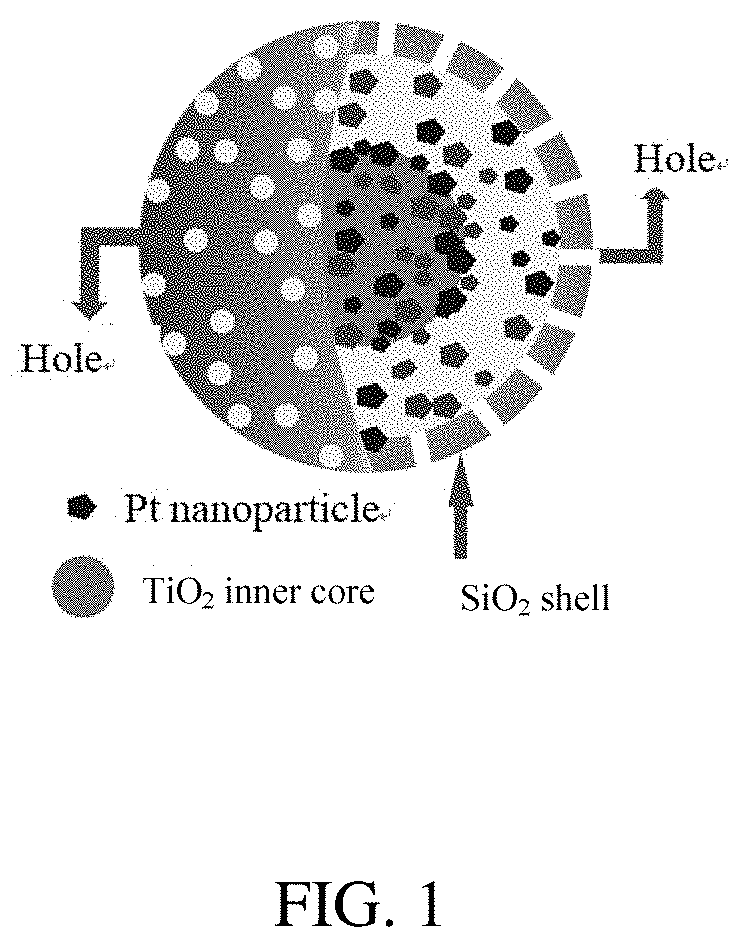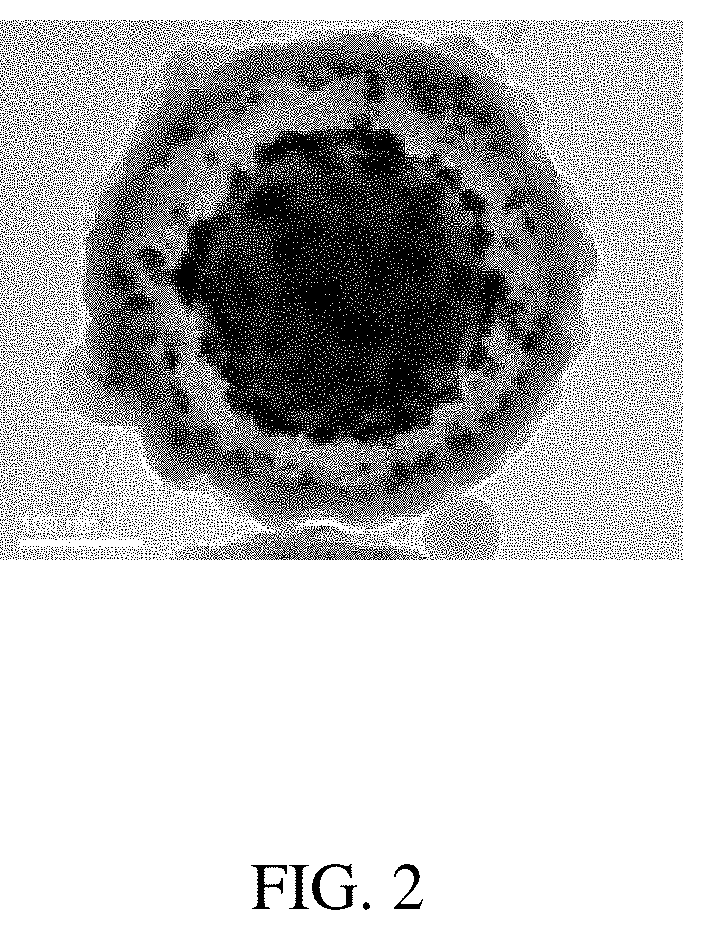Composite photocatalysts, method for making the same and application thereof
a photocatalyst and composite technology, applied in the field of composite photocatalysts, can solve the problems of low catalytic efficiency of the photocatalyst in the actual applicant, the infancy stage of the artificial nanomotor, and the difficulty of researchers in building more complex nanomotors to complete more complex work, etc., to achieve high photocatalytic activity, simple steps, and easy implementation
- Summary
- Abstract
- Description
- Claims
- Application Information
AI Technical Summary
Benefits of technology
Problems solved by technology
Method used
Image
Examples
embodiment 1
[0125]Referring to FIGS. 1 and 2, a composite photocatalyst is provided. The composite photocatalyst includes a spherical core-shell nanomotor and Pt nanodendrites dispersed in the nanomotor. And the nanomotor includes a single TiO2 inner core, a porous SiO2 shell encasing the TiO2 inner core, and a cavity between the SiO2 shell and the TiO2 inner core. The Pt nanodendrites are dispersed in the cavity. The SiO2 shell is a hollow structure and includes a plurality of holes. The diameter of the plurality of holes is about 4 nm.
[0126]Referring to FIG. 3, a method for making the composite photocatalyst is provided. The method includes following steps:
[0127](1) preparing the nanomotor by following steps (a) to (d), as shown in FIGS. 5A and 5B:[0128](a) pretreating TiO2 nanoparticles: adding titanium dioxide nanoparticle of about 300 mg to a NaOH solution with a molar concentration of about 0.8 mol / L; after magnetic stirring treatment at about 800 round per minute for about 10 hours, and ...
embodiment 2
[0145]Referring to FIG. 10, a composite photocatalyst is provided. The composite photocatalyst includes a spherical core-shell nanomotor and Pt nanodendrites dispersed in the nanomotor. And the nanomotor includes a plurality of TiO2 inner cores, a porous SiO2 shell encasing the TiO2 inner cores, and a cavity between the SiO2 shell and the TiO2 inner cores. The Pt nanodendrites are dispersed in the cavity. The difference between the composite photocatalyst of embodiment 2 and that of embodiment 1 is that the nanomotor includes the plurality of TiO2 inner cores Pt nanodendrites.
[0146]Referrring to FIG. 11, a method for making the composite photocatalyst is provided. The method of making the composite photocatalyst of embodiment 2 is the same as the method of making the composite photocatalyst of embodiment 1, except preparing the nanomotor including the plurality of TiO2 inner cores. The method for preparing the nanomotor by following steps (a′) to (d′):
[0147](a′) pretreating TiO2 nan...
embodiment 3
[0151]A composite photocatalyst is provided. The composite photocatalyst includes a tubular core-shell nanomotor and Pd nanoparticles dispersed in the nanomotor. And the nanomotor includes a TiO2 inner core, a porous SiO2 shell encasing the TiO2 inner core, and a cavity between the SiO2 shell and the TiO2 inner core. The Pd nanoparticles are dispersed in the cavity. The difference between the composite photocatalyst of embodiment 3 and that of embodiment 1 is that the tubular core-shell nanomotor and Pd nanoparticles.
[0152]A method for making the composite photocatalyst is provided. The method of making the composite photocatalyst of embodiment 3 is the same as the method of making the composite photocatalyst of embodiment 1, except making the tubular core-shell nanomotor and Pd precursor mixture, and the Pd precursor mixture includes chloropalladic acid.
PUM
| Property | Measurement | Unit |
|---|---|---|
| diameter | aaaaa | aaaaa |
| diameter | aaaaa | aaaaa |
| diameter | aaaaa | aaaaa |
Abstract
Description
Claims
Application Information
 Login to View More
Login to View More - R&D
- Intellectual Property
- Life Sciences
- Materials
- Tech Scout
- Unparalleled Data Quality
- Higher Quality Content
- 60% Fewer Hallucinations
Browse by: Latest US Patents, China's latest patents, Technical Efficacy Thesaurus, Application Domain, Technology Topic, Popular Technical Reports.
© 2025 PatSnap. All rights reserved.Legal|Privacy policy|Modern Slavery Act Transparency Statement|Sitemap|About US| Contact US: help@patsnap.com



